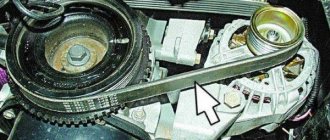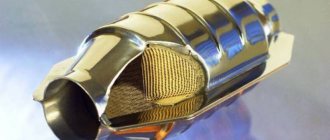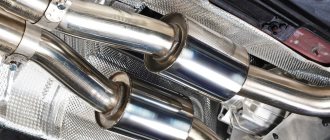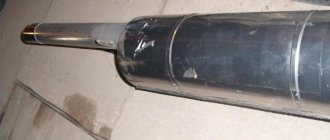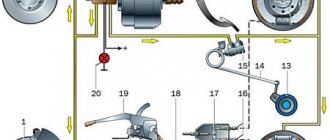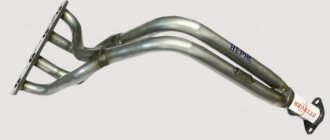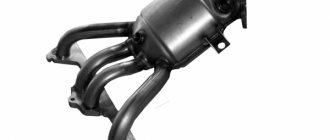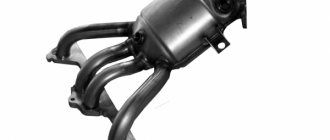Hello, dear friends! I would like to study in more detail such an issue as replacing the catalyst with a flame arrester. Many people strive to carry out such a procedure, sometimes without understanding what it can lead to.
But I will try to be as objective as possible. I will tell you not only about the consequences, but also about what positive aspects arise when replacing the standard catalyst in the exhaust system of a car with a flame arrester or stronger. This is the same concept, but it is the flame arrester that is most widespread among car enthusiasts.
This is not to say that this is a universal element that can be installed always and everywhere. We need to understand this issue and get the most important answers.
Stronger installation work
RamFlow Exhaust Center performs stronger catalytic converter replacements. We have our own spare parts warehouse and also produce custom parts. The work includes several main stages:
- diagnostics of the exhaust system, checking all units and assessing the degree of wear;
- dismantling and disassembling the catalyst;
- removing the filler;
- correct installation of the stronger;
- setting up lambda sensors.
Installing a stronger instead of a catalyst is a complex task that involves serious intervention in the vehicle's exhaust system. It is very important to follow the correct sequence of work, select a suitable flame arrester and perform professional welding. An illiterate approach can lead to negative consequences, the elimination of which will take a lot of time and money from the car owner. Therefore, it is better to entrust the work to professionals.
Signs of problems with the catalyst
Standard catalysts have a limited service life (on average 100,000 km). If you want to install an exhaust stronger, then this should be done when the following symptoms appear:
- increased fuel consumption;
- reduction in engine power;
- difficulty starting the engine;
- toxic smell of exhaust gases;
- the appearance of ringing and rattling from the catalyst.
Also, replacement must be carried out if the catalyst mileage exceeds 200,000 km.
Self-installation of a car stronger
You can replace the catalyst with a flame arrester at any car service center or with your own hands. The most important thing is not to rely on the recommendations of pseudo-masters who supposedly independently replaced the catalyst with a stronger, who advise putting the entire contents of the catalyst out and inserting a straight pipe into it. In this case, the muffler will generally fly, since the flame coming out of the exhaust manifold can burn through the muffler can.
Stronger eliminates the possibility of delaying the flow of hot exhaust. Achieving what you want with your own hands requires the following sequence:
- two metal pipes: the first is the same diameter as the muffler exhaust pipe. The second is slightly larger in diameter;
- Through holes are drilled on the first pipe - 3 mm. It is inserted into a pipe of larger diameter, and the edge is scalded. The edges of the other pipe for bending are slightly cut with a grinder;
- metal scourers (about 30 pieces) are stretched and put on the pipe.
Stronger instead of a catalyst: pros and cons
is a treatment of the effect, not the cause. And it's called "cheating"
. The idea is to remove the second oxygen sensor and seal its seat in the catalyst can. And a diode with a resistor is soldered to the wires, which now forever tells the control unit that everything is great. However, the problem itself has not gone away: no matter how the car didn’t go, it won’t go.
a flame arrester instead
. No, of course, conscious citizens buy a new catalyst, but with the prices of these parts you need to be not only conscious, but also wealthy. Therefore, they install a “flame extinguisher”. The essence of the device is as simple as three kopecks: the same metal barrel, but inside it does not have a tricky honeycomb structure made of expensive materials, but a through pipe with holes.
Through these holes, the flame of the exhaust escaping at enormous speed is dispersed in the outer cavity of the “barrel”. At the same time, the flow rate of gases partially slows down - and then they flow along the path to the exhaust pipe. It is worth noting that advanced car owners often cut this device in garages to suit their taste and color. Therefore, you won’t see any kind of forms, contents and executions on the global network. And also, instead of replacing it with a flame arrester, advanced comrades sometimes simply knock out the ceramic honeycomb of the catalyst with a crowbar, shaking out the remains on the ground.
And then they wonder where the incomprehensible rattling and exhaust sound of the faulty Zaporozhets came from.
cross-section of a typical flame arrester
To a reasonable question, why do you need a flame arrester?
the answer is obvious. To put out the flames. Surprisingly.
If you simply weld a piece of pipe instead, then the hot exhaust gases will very quickly finish off everything that is located further: the corrugation
and even the middle part of the exhaust ( resonator
). No - of course, especially daring street racers do just that, calling it “straight flow”...
But since such comrades’ idea of the structure of a car is based mostly on the Fast and the Furious films, then, of course, this is not a direct flow of any kind. But let's not talk about sad things.
straight-through exhaust in the right way
is a combination of the above actions. Remove the old catalyst, install a high-quality factory flame arrester and silence the second lambda by installing a blende. If you do not take into account the ideal option (replacing the catalyst with a new one), then this algorithm of action will be the most correct.
Car strongers: “what is it” and “why”?
Stronger for a car is an excellent alternative to a catalyst. Another name for a car strongner is a flame arrester. In a simpler interpretation, the stronger, a kind of “technical deception”, is welded into the exhaust system of the car.
Read also: Why do you need a pneumatic bulb?
External characteristics of the flame arrester: a metal pipe, into the internal structure of which a special spiral is embedded.
The domestic automobile market has long been familiar with strongers. But some car owners are hesitant about purchasing a flame arrester. Others consider strongers to be a necessary acquisition for any motorist. But is such a thing necessary?
Advantages of contacting RumFlow
- Guarantee for the work performed. We are confident in the qualifications and experience of our craftsmen. That's why we provide a 1 year warranty.
- Services for any cars. Narrow specialization and experience of more than 12 years allow us to replace catalysts in cars of any brand: from Opel to Aston Martin.
- Own spare parts warehouse. There is no need to wait for the ordered part to arrive. We are the official dealer of Magnaflow, Buzzer, RudEx and so on.
Name Cost, rub. Stronger instead of catalyst from 5,000 ₽ * * Free consultation by phone +7 495 142-09-67
What is a flame arrester and its features
So, before you buy a flame arrester and install this device, you need to know what advantages and disadvantages a flame arrester has instead of a catalyst, the pros and cons of such a solution, etc. Before starting work on replacing the catalyst, it is recommended to study this issue in advance.
A flame arrester is a device that reduces the temperature of exhaust gases and also eliminates resonance as they exit. In other words, the flame arrester effectively lowers the temperature of the exhaust gases and also acts as a primary resonator.
Why do they replace the catalyst with another part in the exhaust?
The main reason for the complete removal of the catalyst from the exhaust tract on cars in our country is the lack of money among owners of old cars, or simple greed. The fact is that this part is quite expensive. Many car owners have excuses that an analogue of the original catalyst cannot be found on our market, but these are just excuses. Instead of a failed old catalytic converter, you can install a universal version. It will definitely be cheaper than the original spare part, and will perform the function of cleaning exhaust gases.
Although, in comparison with complete removal or replacement with another part, the cost of a universal catalyst will still be significantly higher. So they save on exhaust repairs as much as they can, neglecting at least some kind of environmental protection.
And if you change the catalyst to another part, what are the options? Let's look at this in a little more detail.
What is a stronger?
A stronger is a part that is installed in the exhaust system of a car, and which optimizes the operation of this system. Due to its structure, the stronger, due to certain scales that are arranged in a spiral, is able to twist and accelerate the flow of exhaust gases from the exhaust system. This allows for better conductivity of exhaust gases along the exhaust route and also reduces backflow. Backflow is the exhaust back pressure that occurs in the exhaust system. More detailed information and prices can be found below.
Our works
Stronger (flame arrester) is a part of the exhaust system responsible for reducing the temperature and speed of exhaust gases. This facilitates the functioning of vehicle components and improves the exhaust sound. The operating principle of the stronger is based on the absorption and reflection of sound waves. Hot gases leave the combustion chamber at high speed. Once in the stronger, they quickly cool down and slow down. It is more efficient than a catalyst. In addition, the cost of the flame arrester is significantly lower.
What to make a flame arrester from
A flame arrester made from two containers will have an increased service life and good performance.
The housing should be made of stainless steel. In the inner part you will need to place traps, or funnels. The flow of exhaust gases begins to swirl, the speed of this flow decreases and its temperature decreases. It is important to calculate its size when making your own flame arrester. To do this, you should proceed from the engine size and the loads under which it will have to work.
The most common materials used in making a fire extinguisher with your own hands are pipes of different diameters. One is inserted into the other, the ends are thoroughly welded. Sometimes a lot of holes are simply drilled into the inner tube. The space between them is densely filled with material that absorbs unwanted sounds.
A simple substance well suited for this is stone or mineral wool, used in construction to insulate rooms. In addition to high sound insulation, it will not allow the outer casing to heat up too much
At the same time, mineral wool does not weigh much, which is also important
A collector-type flame arrester will last less due to its location. Since it is closer to the combustion chamber, the device will be exposed to higher temperatures. For this reason, it will burn out faster than a flow-through flame arrester.
Welding work should be given increased attention, since during operation it is the welded seams that are most vulnerable. It is they who, after a short period of time, may cause the need for additional repair work.
Alternatively, you can use the outer casing of a deteriorated catalyst. It is cut with a grinder and the insides are removed. Flame arrestor elements are installed in their place, which are also lined with stone wool.
Buy a stronger in Moscow - come to the specialized
If you don’t know whether you need to install a stronger, then you can consult and get advice from the leading specialists of our Lyokha Exhaust car service center, located at the address: Moscow, Sokolnichesky Val 1, building 1, and undergo a free comprehensive detailed diagnostics of the exhaust system Your car. Make an appointment by phone: 8-903-129-20-00
Why put stronger - photo, video, Instagram
Also, you can read: After removing the catalyst, smoke and smell appeared.
Instructions for making a flame arrester with your own hands
So let's move on to the manufacturing procedure, for this we need two iron pipes, one with a diameter equal to the diameter of the exhaust pipe of the muffler, the second with a larger diameter and steel mesh brushes for washing dishes. On a pipe equal to the muffler pipe, we cut out (using gas welding or a drill) holes with a diameter of 3 mm along the entire circle and length. Then we insert this pipe in the center into a pipe of larger diameter and weld it on one side.
Then we stretch the mesh brushes in a circle in the form of a ring, put them on a pipe of a smaller diameter and push them tightly with a metal strip until it rests on the closed end of a pipe of a larger diameter. We continue this procedure until the last mesh brush reaches the free end of a larger diameter pipe. It took me 26 mesh brushes to fill the empty space.
After this, we bend the ends of the pipe of larger diameter, pre-cut with a grinder, and scald them in a circle. This procedure helps to avoid unnecessary ringing noises from the flame arrester during engine operation. For beauty, you can paint it with silver spray paint. Now, with peace of mind, we cut out the catalyst and weld the manufactured flame arrester in its place.
PS A flame arrester instead of a catalyst can be installed on cars with Euro standard 2. On cars with Euro standard above 2, there is an oxygen sensor lambda probe after the catalyst and removing it can lead to an error in the engine control unit, which in turn will increase fuel consumption and worsen dynamics car.
Alternatively, you can make a flame arrester with your own hands on a VAZ
We take an old resonator, it is 2 years old and 45t.km. For the flame arrester body we needed an old muffler. We cut the muffler into metal.
The outer casing of the drain muffler is 2 layers of metal - 0.6 mm on the outside; from the inside - 0.8 mm., by the way, well preserved, slight corrosion between these two layers of metal. Next, look carefully at the photo, everything is clear.
inside…
inside…
The outer diameter of the cut pipe is 80 mm, thickness 1.5 mm, will be used for the flame arrester body.
We use the remaining piece for the end walls, then, due to the reluctance to cut the resonator pipe in half due to the further complexity of the joining, we did this: the flame arrester body was welded, cut lengthwise:
We put the halves on, scald them, then on the outside with a second layer we weld a 0.8 mm thick shirt onto the flanges of the end walls with a gap between the shirts of about 5 mm, the flanges are visible in the previous photos, the result:
On the end walls there is also an additional layer of metal 0.8 mm
then on the flame arrester body there is a noise-sound-heat insulator - a cover with flanges with asbestos fabric inside
We cook the lining from the bottom of the car
Similarly, on the bottom side there is a lining with asbestos for the resonator, we cook:
By the way, there is a decent stench when paraffins come out of asbestos... from heating. Now we clean with a cleaning disc and a metal brush
We degrease and paint with thermal paint (otherwise it will quickly corrode during welding, all welded seams should be thoroughly cleaned with a brush) thermal paint is stated to reach 538 degrees Celsius, we’ll see... By the way, one can was enough to paint three layers, there was one extra can left...
Now in a week I’ll install it somewhere, now I won’t have time, the plans are to remove the old (new) resonator, remove the thermal shields from the bottom, clean and cover the barrier with 2 layers of vibration-mastic, reassemble it in place, and by the way, reinforced suspension cushions of the resonator (weight -something has increased), I hope the metallic sound will go away, or it will become much less, in any case, I will approach the assessment of changes carefully and as objectively as possible, otherwise I somehow got into trouble with the SAAB... The original muffler is straight-through, and these Saab ones are for turbo- engines, the turbine itself dampens the sound quite well and the task there is to remove the exhaust as easily as possible. By the way, between the wall of the original resonator and the outer pipe 1.5 mm thick, I was afraid to shove stainless steel dish brushes, in case they start rubbing against vibrations and pressure and pour into the exhaust or even into the engine, write comments and we’ll discuss
Yes, I almost forgot - the stock silencer has stainless steel end walls and an exhaust tip, a mysterious Russian soul, if the 2 outer skins were made of stainless steel, it would be an indestructible silencer because Everything inside is practically new.
Source
Motorist's benefit
